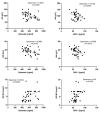Dynamics of Bone Disease Biomarkers Dickkopf-1 and Sclerostin in Patients with Multiple Myeloma
- PMID: 37445475
- PMCID: PMC10342782
- DOI: 10.3390/jcm12134440
Dynamics of Bone Disease Biomarkers Dickkopf-1 and Sclerostin in Patients with Multiple Myeloma
Abstract
Dickkopf-1 (DKK-1) and sclerostin are essential Wnt/β-catenin pathway inhibitors, playing an important role in multiple myeloma bone disease (MBD). We aimed to examine the serum DKK-1 and sclerostin variations in newly diagnosed multiple myeloma (NDMM) patients at diagnosis and in the course of therapy, including autologous stem cell transplantation (ASCT). This study included 41 NDMM-patients and 33 controls. MBD was assessed by whole-body low-dose computed tomography. DKK-1 and sclerostin were assayed by commercial ELISA kits. At diagnosis, NDMM-patients revealed significantly higher DKK-1 and sclerostin values (p < 0.0001), showing dependence on disease stage (lowest in ISS-I and highest in ISS-III: p < 0.0012 and p < 0.025, respectively, for both proteins). Bone lesions revealed significant positive correlation with both DKK-1 (p < 0.05) and sclerostin (p < 0.0001). In the course of therapy, significant reduction, more prominent after ASCT, was observed for both parameters in each treatment point compared to the baseline (p < 0.0001). Markedly lower sclerostin (p < 0.01) and DKK-1 (p < 0.05) values were observed in patients with complete and very good partial response compared to those with partial response, stable, or progressive disease. Sclerostin and DKK-1 in NDMM patients reflect the MBD severity and the effect of therapy. Both proteins could represent a novel tool for better disease monitoring and effectiveness of therapy.
Keywords: Dickkopf-1; multiple myeloma bone disease; sclerostin.
Conflict of interest statement
The authors declare no conflict of interest. The funder had no role in the design of the study; in the collection, analyses, or interpretation of data; in the writing of the manuscript; or in the decision to publish the results.
Figures







Similar articles
-
Circulating sRANKL, Periostin, and Osteopontin as Biomarkers for the Assessment of Activated Osteoclastogenesis in Myeloma Related Bone Disease.Cancers (Basel). 2023 Nov 24;15(23):5562. doi: 10.3390/cancers15235562. Cancers (Basel). 2023. PMID: 38067265 Free PMC article.
-
Factors associated with serum soluble inhibitors of Wnt-β-catenin signaling (sclerostin and dickkopf-1) in patients undergoing peritoneal dialysis.Nephrology (Carlton). 2015 Sep;20(9):639-45. doi: 10.1111/nep.12509. Nephrology (Carlton). 2015. PMID: 25974190
-
Wnt signaling pathway inhibitors, sclerostin and DKK-1, correlate with pain and bone pathology in patients with Gaucher disease.Front Endocrinol (Lausanne). 2022 Nov 24;13:1029130. doi: 10.3389/fendo.2022.1029130. eCollection 2022. Front Endocrinol (Lausanne). 2022. PMID: 36506070 Free PMC article.
-
Dickkopf-1: a suitable target for the management of myeloma bone disease.Expert Opin Ther Targets. 2009 Jul;13(7):839-48. doi: 10.1517/14728220903025770. Expert Opin Ther Targets. 2009. PMID: 19530987 Review.
-
Pathogenesis and Treatment of Myeloma-Related Bone Disease.Int J Mol Sci. 2022 Mar 14;23(6):3112. doi: 10.3390/ijms23063112. Int J Mol Sci. 2022. PMID: 35328533 Free PMC article. Review.
Cited by
-
Advances in Supportive Care for Multiple Myeloma-Related Bone Disease-A Review.Cancers (Basel). 2025 Jun 27;17(13):2166. doi: 10.3390/cancers17132166. Cancers (Basel). 2025. PMID: 40647466 Free PMC article. Review.
-
Genetic, epigenetic, and molecular determinants of multiple myeloma and precursor plasma cell disorders: a pathophysiological overview.Med Oncol. 2025 Jun 3;42(7):234. doi: 10.1007/s12032-025-02807-0. Med Oncol. 2025. PMID: 40459694 Review.
-
Circulating sRANKL, Periostin, and Osteopontin as Biomarkers for the Assessment of Activated Osteoclastogenesis in Myeloma Related Bone Disease.Cancers (Basel). 2023 Nov 24;15(23):5562. doi: 10.3390/cancers15235562. Cancers (Basel). 2023. PMID: 38067265 Free PMC article.
-
Challenges, Difficulties, and Delayed Diagnosis of Multiple Myeloma.Diagnostics (Basel). 2025 Jul 4;15(13):1708. doi: 10.3390/diagnostics15131708. Diagnostics (Basel). 2025. PMID: 40647707 Free PMC article. Review.
-
Preventing Skeletal-Related Events in Newly Diagnosed Multiple Myeloma.Cells. 2025 Aug 15;14(16):1263. doi: 10.3390/cells14161263. Cells. 2025. PMID: 40862742 Free PMC article. Review.
References
-
- Cowan A.J., Allen C., Barac A., Basaleem H., Bensenor I., Curado M.P., Foreman K., Gupta R., Harvey J., Hosgood H.D., et al. Global Burden of Multiple Myeloma: A Systematic Analysis for the Global Burden of Disease Study 2016. JAMA Oncol. 2018;4:1221–1227. doi: 10.1001/jamaoncol.2018.2128. - DOI - PMC - PubMed
Grants and funding
LinkOut - more resources
Full Text Sources

